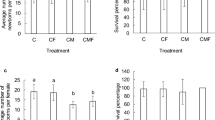Abstract
It is generally assumed that the dissolved fraction of a toxic substance in surface water is mainly responsible for toxicity to aquatic organisms. However, toxic compounds are often adsorbed or chemically bound to suspended particles in the water column, depending upon the physico-chemical conditions. In the present study potential adverse effects to filter feeding organisms by metal contaminated particles were investigated. In our hypotheses the adsorbed metals might desorb in the gastrointestinal tract—due to different physico-chemical conditions—and exert toxic effects.
Clay and sand particles, algae and organic material (peat) were artificially contaminated with cadmium and zinc. The contaminated materials were resuspended in standard conditions and toxicity was measured for the water flea Daphnia magna (mortality at 48 hours). As a reference, supernatant solutions were used containing the same concentration of dissolved metal as the suspensions. It was also established that the test concentrations of solid material (250 and 500 mg/l uncontaminated particles) did not cause any mortality within 48 hours. Daphnids are filter feeders: they filtrate large amounts of surrounding water, redrawing particles as a food source. Results strongly indicate that contaminated particles threaten the health of these particle-feeding organisms. Compared to the reference severe acute toxic effects were seen and cadmium accumulation was increased when contaminated solid material was present. Results were essentially the same for the different materials used in the experiments, except for sand contaminated with cadmium. This shows that mineral as well as organic materials can contribute to the particle bound toxicity.
Different results were obtained when a static set up was used instead of a flow through set up, illustrating that the route of administration is important to make particles available and thus to evaluate their toxicity.
Contaminated particles clearly have toxic potency, not only because they are a continuous source of dissolved xenobiotics, but also because the particle bound fraction can become available within the body of particle feeding organisms. This could lead to unexpected high tissue concentrations. More insight is needed to predict the bioavailability of adsorbed pollutants. Results of this study already indicate that suspended solids should be considered as a separate compartment in risk evaluation of chemicals, effluents or natural surface waters.
Similar content being viewed by others
Author information
Authors and Affiliations
Additional information
Received: 21 September 1999/Accepted: 21 March 2000
Rights and permissions
About this article
Cite this article
Weltens, R., Goossens, R. & Van Puymbroeck, S. Ecotoxicity of Contaminated Suspended Solids for Filter Feeders (Daphnia magna). Arch. Environ. Contam. Toxicol. 39, 315–323 (2000). https://doi.org/10.1007/s002440010110
Issue Date:
DOI: https://doi.org/10.1007/s002440010110




